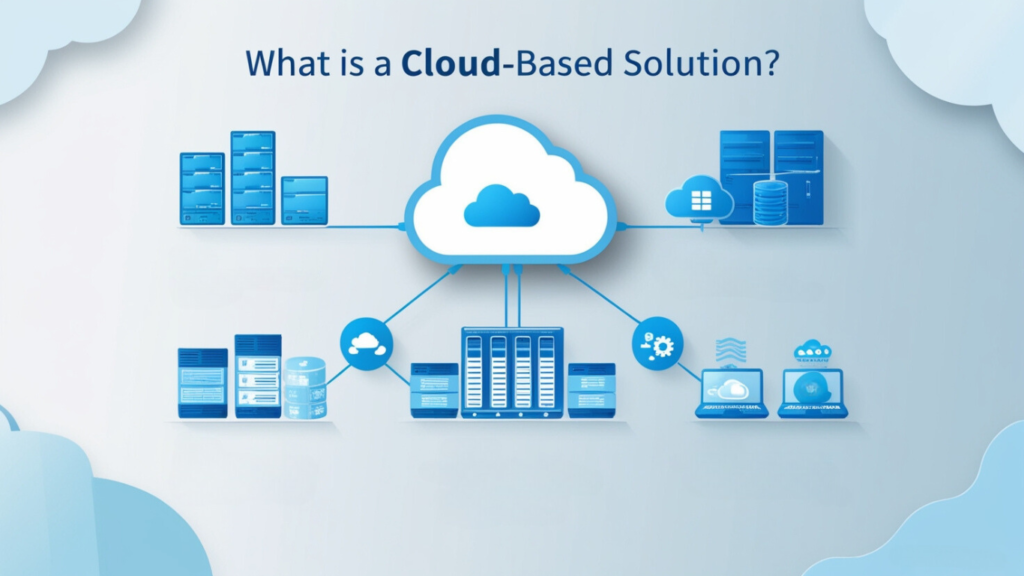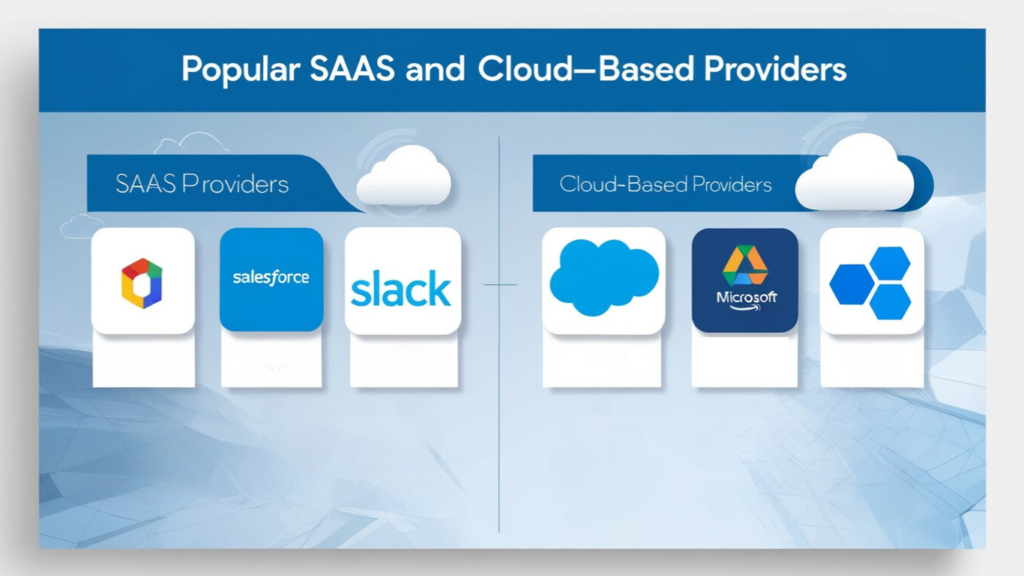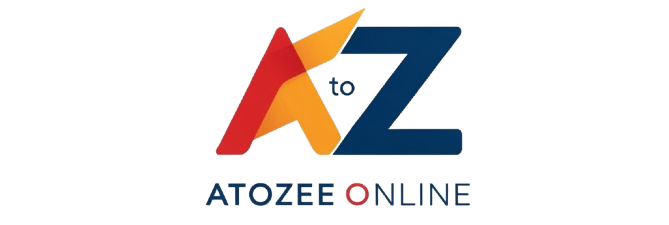SaaS-Based vs Cloud-Based Solutions

SaaS-Based vs Cloud-Based Solutions
Learn the key differences between SaaS-based and cloud-based solutions. Discover which model is right for your business and how each can improve efficiency.
Introduction:
As businesses continue to digitize their operations, choosing the right technology model is crucial for long-term success. Two popular options that often come up in discussions are SaaS-based and cloud-based solutions. While these terms are sometimes used interchangeably, they represent different approaches in the cloud computing ecosystem. This comprehensive guide will explore the differences between SaaS (Software as a Service) and broader cloud-based solutions, covering their features, benefits, and use cases. By understanding how each model operates, you can decide which solution best fits your business needs.
What is SaaS-Based?

- SaaS (Software as a Service) is a cloud computing model in which applications are hosted and maintained by a third-party provider and delivered over the Internet. Users access these applications via a web browser, eliminating the need for local installation or on-site software management.
- SaaS-based solutions have become popular due to their ease of use, flexibility, and low upfront costs. Common examples of SaaS include productivity tools, customer relationship management (CRM) platforms, and project management software.
Core Features of SaaS-Based Solutions:
- Subscription Model:
SaaS products are typically sold via subscription plans, where users pay a monthly or annual fee to access the software. This model makes it cost-effective for businesses as they avoid large upfront software purchases. - No Installation Required:
One of the major advantages of SaaS is that it doesn’t require local installation. Users can access the software directly from their browser, allowing quick deployment. - Automatic Updates:
With SaaS, the provider manages all updates and patches. Users are always on the latest software version without worrying about manually upgrading. - Scalability:
SaaS solutions are highly scalable. Businesses can easily add or remove users or features based on their needs, making it an ideal option for growing companies.
Examples of SaaS Applications:
- Google Workspace (formerly G Suite):
Offers tools like Gmail, Google Drive, and Google Docs. - Salesforce:
A cloud-based CRM system that helps businesses manage customer relationships. - Slack:
A team collaboration tool that allows for instant messaging, file sharing, and integrations with other apps.
What is a Cloud-Based Solution?

Cloud-based solutions refer to any service or Infrastructure delivered over the Internet, not just software. Cloud computing offers a wide range of services, including Infrastructure as a Service (IaaS), Platform as a Service (PaaS), and Software as a Service (SaaS). Each model serves a different purpose but operates within the same cloud environment.
Types of Cloud-Based Solutions:
- Infrastructure as a Service (IaaS):
IaaS provides virtualized computing resources over the Internet. It allows businesses to rent servers, storage, and networking infrastructure, eliminating the need for physical hardware. IaaS is highly customizable and ideal for organizations that require significant control over their IT environments. - Platform as a Service (PaaS):
PaaS offers a platform allowing developers to build, test, and deploy applications. It provides an environment with pre-configured tools that simplify application development. PaaS is commonly used by businesses looking to streamline the development process without managing the underlying Infrastructure. - Software as a Service (SaaS):
As discussed, SaaS is a cloud-based software delivery model. Although it’s just one aspect of cloud-based services, it’s the one most end users interact with.
Key Features of Cloud-Based Solutions:
- On-Demand Resources:
Cloud-based solutions provide businesses with access to computing resources on demand without requiring them to purchase or maintain physical hardware. - Customization and Control:
With IaaS and PaaS, businesses have greater flexibility and control over their cloud environments. They can configure servers, storage, and networks according to their needs. - Broad Range of Services:
Cloud-based solutions span various industries and functions, including data storage, application hosting, and even artificial intelligence (AI) processing. - Global Accessibility:
Cloud-based solutions allow for global access, enabling employees and customers to interact with resources from anywhere worldwide, as long as they have an internet connection.
Examples of Cloud-Based Solutions:
- Amazon Web Services (AWS):
A leading provider of IaaS and PaaS, offering services such as virtual servers, storage, and machine learning tools. - Microsoft Azure:
A cloud platform that provides Infrastructure, analytics, and AI services alongside support for application development. - Google Cloud:
Known for its scalable infrastructure services, data analytics, and machine learning capabilities.
SaaS-Based vs Cloud-Based Solutions: Key Differences:
| Criteria | SaaS-Based Solutions | Cloud-Based Solutions |
|---|---|---|
| Definition | Delivers fully functional software applications via the internet. | Provides a broader range of services (IaaS, PaaS, SaaS) over the cloud. |
| Control | Minimal control over software infrastructure; users can only customize the application interface. | High control over infrastructure; users can configure servers, storage, and networks. |
| Maintenance & Updates | Handled by the SaaS provider; automatic updates and patches. | Businesses are responsible for updates and maintenance for IaaS/PaaS; SaaS is vendor-managed. |
| Deployment | Fast and straightforward; no installation needed, access through a browser. | More complex, especially for IaaS and PaaS; requires technical setup. |
| Cost Structure | Typically subscription-based, with predictable pricing. | Pay-as-you-go for infrastructure; customizable cost based on resource usage. |
| Scalability | Highly scalable in terms of users and features, but limited control over backend scalability. | Full scalability over infrastructure and resources; businesses can scale based on demand. |
| Use Cases | Best for accessing ready-to-use software (e.g., email, CRM, project management). | Ideal for businesses needing infrastructure or platforms to build, host, or deploy applications. |
SaaS-Based vs. Cloud-Based: Which Is Best for Your Business?
| Criteria | SaaS-Based Solutions | Cloud-Based Solutions |
|---|---|---|
| Best For | Small and Medium-Sized Businesses (SMBs) that need easy-to-use software without the burden of managing infrastructure. | Large enterprises or companies with complex IT needs, requiring custom infrastructure or platforms for application development. |
| Deployment Time | Quick to deploy, typically ready to use after sign-up. | More complex to deploy, requiring setup and configuration by IT teams. |
| Cost Structure | Subscription-based pricing with predictable monthly or annual costs. | Pay-as-you-go model for infrastructure; costs vary based on resource usage. |
| Customization | Limited customization options, mostly confined to application interface settings. | Highly customizable; users can control and configure the infrastructure or development platforms. |
| Scalability | Easily scalable for adding/removing users but with limited control over backend scalability. | Highly scalable in terms of infrastructure, storage, and computational power to meet growing business needs. |
| IT Requirements | Minimal IT resources needed; vendor manages updates, security, and maintenance. | Requires more IT involvement for managing infrastructure, security, and deployment. |
Benefits of SaaS-Based Solutions:
| Benefits | Description |
|---|---|
| Cost Savings | No need for hardware or on-premises software; subscription-based pricing makes it affordable. |
| Quick Deployment | SaaS applications are ready to use with minimal setup, reducing time-to-market. |
| Vendor Managed | All maintenance, updates, and security are handled by the provider, reducing the IT burden. |
| Scalability | SaaS platforms can easily scale up or down based on the number of users or features needed. |
| Accessibility | Users can access SaaS applications from anywhere with an internet connection. |
| Automatic Updates | Software updates are managed by the vendor, ensuring users always have the latest features and patches. |
Benefits of Cloud-Based Solutions:
| Benefits | Description |
|---|---|
| Infrastructure Flexibility | Businesses can rent computing resources as needed, making it easy to scale based on demand. |
| Customization | IaaS and PaaS solutions offer full control over infrastructure, allowing businesses to configure according to their needs. |
| Global Reach | Cloud infrastructure allows businesses to deploy services globally without investing in physical data centers. |
| Cost-Efficient Scalability | Pay-as-you-go pricing ensures businesses only pay for the resources they use. |
| Supports Complex Workloads | Cloud platforms can handle demanding workloads, such as AI, big data, and machine learning. |
| Disaster Recovery | Cloud services often include built-in redundancy and disaster recovery, enhancing business continuity. |
Popular SaaS and Cloud-Based Providers:
| Provider | Type | Description |
|---|---|---|
| Google Workspace | SaaS | A suite of productivity tools including Gmail, Drive, and Docs. |
| Salesforce | SaaS | A leading CRM platform for managing customer relationships. |
| Slack | SaaS | A communication platform designed for team collaboration and messaging. |
| Amazon Web Services (AWS) | Cloud-Based (IaaS, PaaS) | Offers infrastructure and platform services such as EC2, S3, and Lambda. |
| Microsoft Azure | Cloud-Based (IaaS, PaaS) | A comprehensive cloud platform for infrastructure, AI, and app development. |
| Google Cloud | Cloud-Based (IaaS, PaaS) | A robust cloud service provider known for big data, AI, and scalable computing solutions. |

Conclusion:
- SaaS-based and cloud-based solutions are critical in modern business operations but cater to different needs. SaaS-based solutions provide easy, cost-effective access to software, ideal for businesses that need quick, scalable, and low-maintenance tools. Cloud-based solutions, such as IaaS and PaaS, offer greater flexibility, customization, and control, making them ideal for larger enterprises or businesses with specific IT needs.
- Ultimately, the right solution depends on your business’s goals, budget, and technical capacity. Whether you choose SaaS for simplicity or cloud-based infrastructure for flexibility, both models can drive efficiency, scalability, and growth in today’s competitive market.
FAQs:
- What is the main difference between SaaS and cloud-based solutions?
SaaS delivers fully functional software applications over the cloud, while cloud-based solutions include a broader range of services, such as infrastructure (IaaS) and platforms (PaaS). - Is SaaS considered a cloud-based solution?
Yes, SaaS is a cloud-based service that focuses specifically on providing software applications via the Internet. - Do SaaS applications require installation?
No, SaaS applications are accessed via a web browser and do not require local installation on a user’s device. - Which is more flexible, SaaS or cloud-based solutions?
Cloud-based solutions, especially IaaS and PaaS, are more flexible as they allow for the customization of infrastructure and applications, whereas SaaS offers less control over configuration. - Is SaaS suitable for large enterprises?
SaaS can be suitable for large enterprises, but organizations with complex IT needs may also require cloud infrastructure services (IaaS or PaaS) for additional customization and scalability.





Thank you for the auspicious writeup. It in fact was a amusement account it. Look advanced to far added agreeable from you! However, how can we communicate?